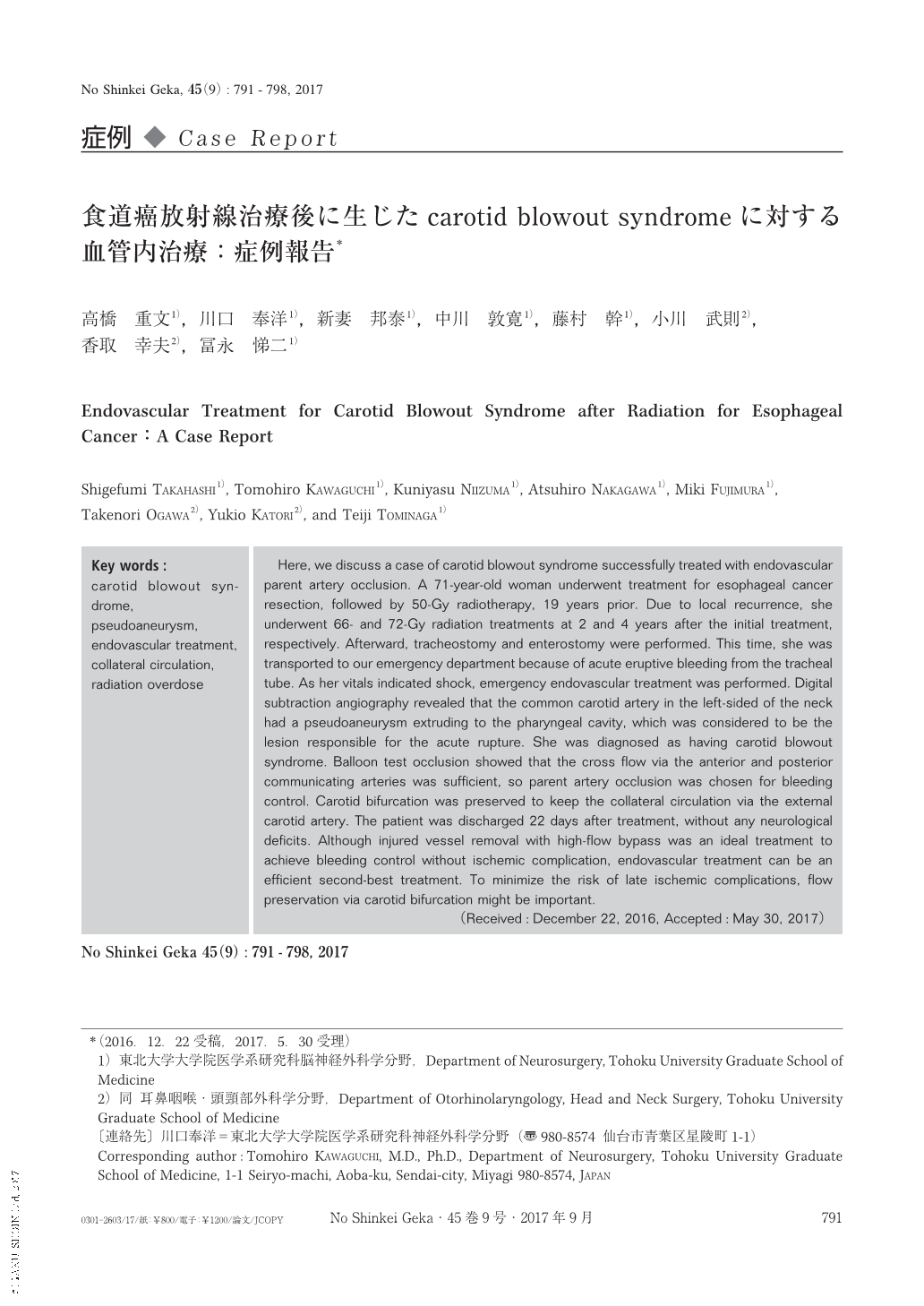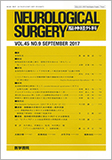Japanese
English
- 有料閲覧
- Abstract 文献概要
- 1ページ目 Look Inside
- 参考文献 Reference
Ⅰ.はじめに
食道癌は,40〜60代の男性に好発する予後不良の悪性腫瘍である.術後追加治療や再発時の治療選択として放射線治療が選択されることが多く,局所制御率の高さや機能温存の点で優れている10,21,23,24).近年,治療成績が向上する一方で,放射線治療後の晩期合併症が無視できなくなってきた.Carotid blowout syndromeは頭頚部腫瘍に対する放射線治療から数年経過した後に発症し,頭蓋外内頚動脈破裂を引き起こす重篤な合併症である3,13).ほとんどの場合が破裂もしくは切迫破裂として発症するため,治療選択に時間的猶予がなく,生命予後,機能予後ともに極めて不良(罹患率60%,死亡率40%)な病態である8,12,14,17-20).
Carotid blowout syndromeは稀な病態であり,症例報告が散見されるのみである.治療選択に関するまとまった報告はほとんどなく,経験的に多くの症例に対して血管内治療が選択されている5,6,11).血管内治療においては,虚血耐性を評価した後に,順行性血流を温存するカバー付きステント留置や,コイルによる親動脈閉塞術が選択されるが,いずれの場合も再出血または脳梗塞の危険性が高いことが解決すべき課題である.
今回われわれは,食道癌に対する複数回の放射線治療後に発症したcarotid blowout syndrome症例を経験した.血管内治療による親動脈閉塞術を施行し,外頚動脈を温存することで出血制御と側副血行温存が両立され,良好な転帰が得られた.Carotid blowout syndromeに対する血管内治療の問題点および留意すべき点について,文献的考察を加えて報告する.
Here, we discuss a case of carotid blowout syndrome successfully treated with endovascular parent artery occlusion. A 71-year-old woman underwent treatment for esophageal cancer resection, followed by 50-Gy radiotherapy, 19 years prior. Due to local recurrence, she underwent 66- and 72-Gy radiation treatments at 2 and 4 years after the initial treatment, respectively. Afterward, tracheostomy and enterostomy were performed. This time, she was transported to our emergency department because of acute eruptive bleeding from the tracheal tube. As her vitals indicated shock, emergency endovascular treatment was performed. Digital subtraction angiography revealed that the common carotid artery in the left-sided of the neck had a pseudoaneurysm extruding to the pharyngeal cavity, which was considered to be the lesion responsible for the acute rupture. She was diagnosed as having carotid blowout syndrome. Balloon test occlusion showed that the cross flow via the anterior and posterior communicating arteries was sufficient, so parent artery occlusion was chosen for bleeding control. Carotid bifurcation was preserved to keep the collateral circulation via the external carotid artery. The patient was discharged 22 days after treatment, without any neurological deficits. Although injured vessel removal with high-flow bypass was an ideal treatment to achieve bleeding control without ischemic complication, endovascular treatment can be an efficient second-best treatment. To minimize the risk of late ischemic complications, flow preservation via carotid bifurcation might be important.

Copyright © 2017, Igaku-Shoin Ltd. All rights reserved.


